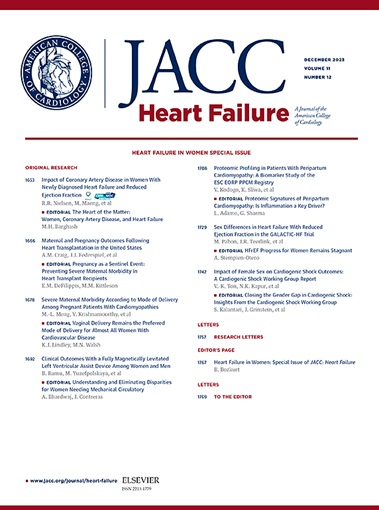First-in-Human Implantable Inferior Vena Cava Sensor for Remote Care in Heart Failure
IF 10.3
1区 医学
Q1 CARDIAC & CARDIOVASCULAR SYSTEMS
引用次数: 0
Abstract
Background
Variations of inferior vena cava (IVC) area and collapsibility serve as early markers of congestion and predict risk for heart failure (HF) events.
Objectives
The aim of this first-in-human study (FUTURE-HF [First in Human Clinical Investigation of the FIRE1 System in Heart Failure Patients]) was to evaluate the safety and feasibility of a novel implantable IVC sensor for remote management in patients with HF. This paper is the final report on primary (3-month) and exploratory (6-month) endpoints.
Methods
Patients with HF hospitalizations within the previous year, with elevated natriuretic peptide levels, and on optimal HF treatment were included. The primary safety endpoints were procedural success without device- or procedure-related complications at 3 months. The primary technical endpoint was signal acquisition following implantation and at a clinic visit within 3 months. Sensor-derived IVC area was compared with computed tomography (CT)–based IVC dimensions. Patient adherence to daily readings and exploratory clinical findings at 6 months were assessed.
Results
Fifty patients underwent successful implantation (mean age 65 ± 9 years, 14% women, 72% in NYHA functional class III), with 49 contributing to the primary safety and technical endpoints at 3 months. Sensor-derived IVC area demonstrated excellent agreement with CT measurement (mean absolute error 13.53 mm2 [3.55%] R2 = 0.98). Median adherence was 96% at 6-month follow-up. Exploratory analyses of clinical outcomes suggested improvements in N-terminal pro–B-type natriuretic peptide, NYHA functional class, and quality of life and reduced HF events.
Conclusions
This first-in-human experience demonstrated that the implantation of an IVC sensor was safe and feasible. Sensor-derived IVC area demonstrated excellent correlation with CT-derived IVC area, and exploratory clinical outcomes suggest that this may serve as a novel tool for ambulatory management of congestion to facilitate remote care in HF. (First in Human Clinical Investigation of the FIRE1 System in Heart Failure Patients [FUTURE-HF]; NCT04203576).
用于心力衰竭远程护理的首次人类植入式下腔静脉传感器:FUTURE-HF
下腔静脉(IVC)面积和可折叠性的变化是充血的早期标志,可预测心力衰竭(HF)事件的风险。
本文章由计算机程序翻译,如有差异,请以英文原文为准。
求助全文
约1分钟内获得全文
求助全文
来源期刊

JACC. Heart failure
CARDIAC & CARDIOVASCULAR SYSTEMS-
CiteScore
21.20
自引率
2.30%
发文量
164
期刊介绍:
JACC: Heart Failure publishes crucial findings on the pathophysiology, diagnosis, treatment, and care of heart failure patients. The goal is to enhance understanding through timely scientific communication on disease, clinical trials, outcomes, and therapeutic advances. The Journal fosters interdisciplinary connections with neuroscience, pulmonary medicine, nephrology, electrophysiology, and surgery related to heart failure. It also covers articles on pharmacogenetics, biomarkers, and metabolomics.
 求助内容:
求助内容: 应助结果提醒方式:
应助结果提醒方式:


